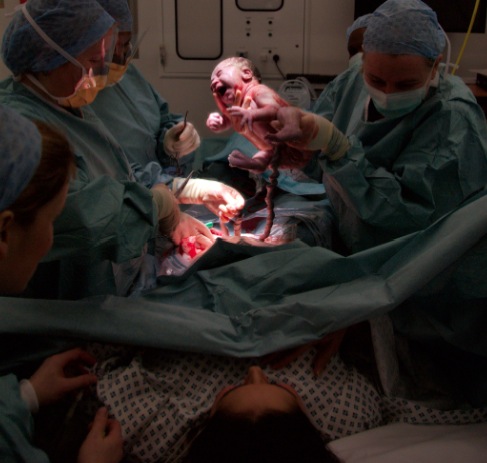Advertisement
Beyond Blame: Yes, Too Many C-Sections, But No, Not Bad Moms
WBUR reporter Martha Bebinger recently published a story on childbirth quality data to help pregnant women and their families compare hospitals across Massachusetts. Here, she shares a personal reaction to some of the more troubling feedback she got about Cesarean sections.

I am not a bad mother because I had a Cesarean section. If you had one, neither are you.
Most if not all doctors who have high rates of C-sections are not bad doctors.
C-sections happen as a result of many decisions, some good, some bad.
In some cases (possibly mine) they save the life of the mom and baby. In other cases they are avoidable if not unnecessary.
If we want fewer of them, we have to look at all the steps that lead to a C-section and find the decisions that most often lead to missteps. Pointing fingers at moms, docs, hospitals or anyone else (partners, lawyers, etc.) won't help.
That's my water cooler summary on C-sections after several months of looking at childbirth quality measures and C-sections in particular. I hated hearing from moms who felt like we belittled their experience by suggesting that there are too many C-sections.
Our point in the series was to alert everyone to the range of C-section rates and to help mothers be more aware of the factors that lead to a C-section. It is up to the medical system as a whole to analyze what goes wrong and reduce the number of C-sections. The last thing we wanted to do was to blame mothers.
Here's my C-section story. I'd love to hear yours.
In my mid thirties, when I finally decided to have child, I also decided that I really wanted to give birth. Conception and pregnancy were the beginning and middle of an experience I wanted to be right there in the thick of to the end. I only planned to give birth to one child, so I wanted to choose the package, which in my case was a vaginal delivery.
I signed on with a small office with one OB and one midwife. I toured the natural birth center at my local hospital and I got the hospital administration to agree that my acupuncturist could be on hand, with needles for my delivery.
Then, one gray November day, I got to 10 centimeters over the space of about 12 hours and heard my OB say "oh my." My son was breech. It was hard to absorb this news in between contractions. Dr. Vigliani, whom I love, did some calculations and decided my son was too big to try to pull out feet first. The timing got a little dicey and I had an emergency C-section.
I was sad to miss the natural birth experience, but I left the hospital with a beautiful, healthy, bouncing (9.8 oz.) baby boy. I decided not to dwell on how he came out. It did not occur to me to feel guilty about having a C-section. I tried for a vaginal delivery, it didn’t work out. It wasn’t my fault or anyone else’s. Would anyone have expected me to risk pushing out the body of my son only to have his head get stuck? In an earlier era, we might both have died.
So when I hear doctors say hospitals are doing too many C-sections, I never imagine that these experts are talking about me. I've always assumed, perhaps naively, that I’m firmly in the "up to 15%" group of C-sections the World Health Organization says may be medically necessary. If I'm wrong, I don't care. Everything turned out just fine.
